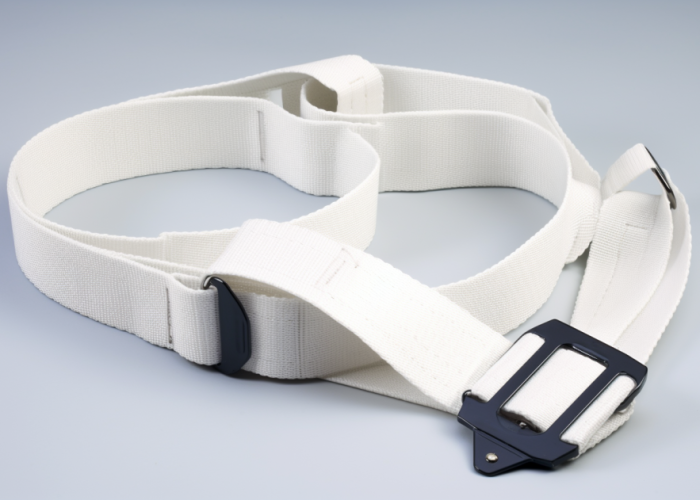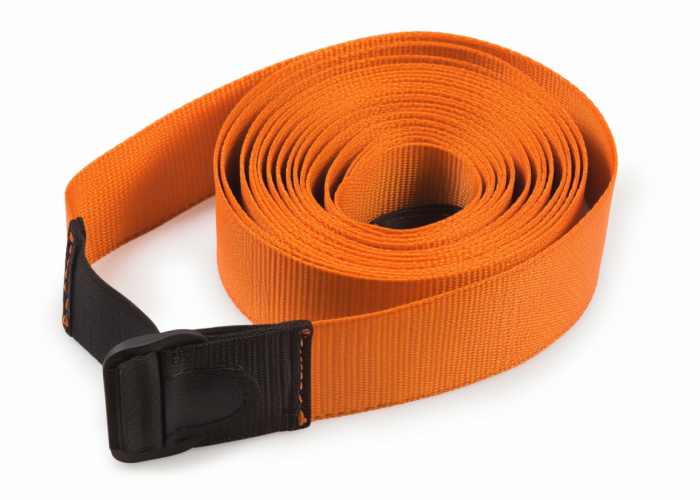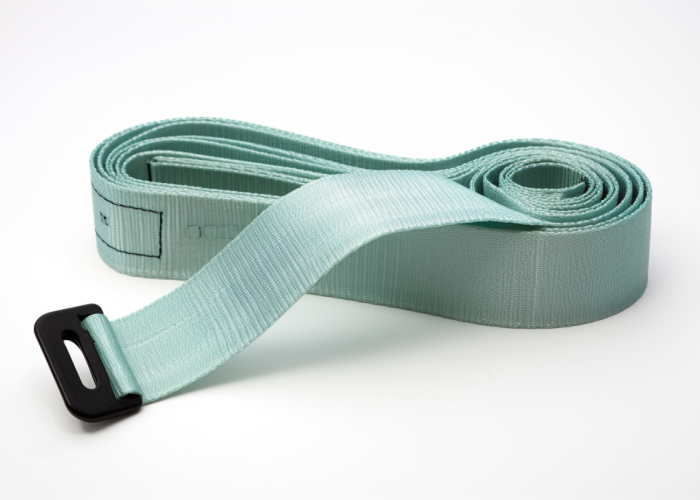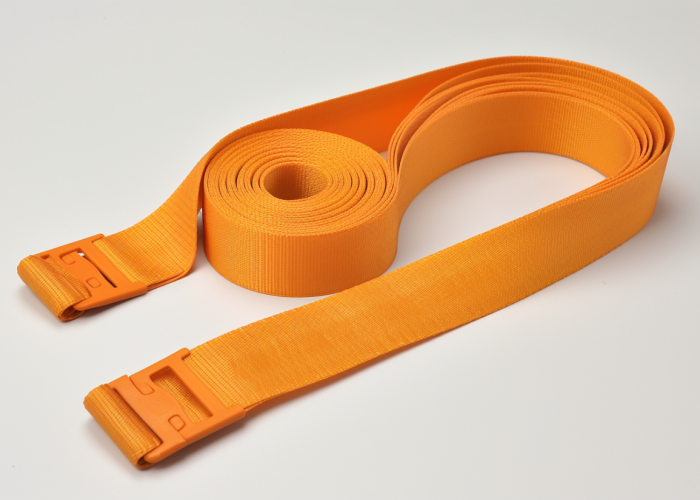Positioning straps are critical components in healthcare settings where patient safety and procedural accuracy are essential. Our custom webbing manufacturing delivers positioning straps with precise tensile strength, biocompatibility, and specialized attachments tailored to your product specifications.
Positioning straps are essential medical devices used across healthcare settings including surgical procedures, anesthesia administration, diagnostic imaging, and emergency care. These restraints ensure patient safety, maintain proper alignment, and enhance procedural accuracy.
Explore applications, technical specs, and material tips for positioning straps to support your medical device development across clinical use cases.


Webbing manufacturing expert with 15+ years of experience helping product developers build high-performance straps for industrial, medical, and outdoor use.
Positioning straps in surgical procedures are essential for securing patients in correct anatomical positions while preventing movement that could compromise surgical outcomes. These specialized restraints distribute pressure evenly across contact points, minimize the risk of pressure ulcers, and prevent inadvertent patient movement that could lead to surgical complications or staff injuries during critical procedures.
Key Points
Effective use of positioning straps during surgery hinges on strength ratings, sterilization durability, anatomical compatibility, and procedural specificity.
Surgical positioning straps require specific tensile strength ratings—300-500 pounds for standard procedures and up to 1,000 pounds for bariatric applications. Material durability is critical, with straps needing to maintain integrity through 50-100 autoclave cycles at 134°C. For imaging-guided procedures, radiolucent materials prevent artifacts that could interfere with surgical accuracy.
Proper strap placement varies by procedure. In supine positions, straps secure across mid-thigh and upper chest, positioned 2 inches above pressure points. Lateral positioning requires specialized axillary and pelvic straps with padded interfaces to prevent nerve injuries and maintain alignment.
Research shows standardized positioning protocols reduce pressure injuries by 28-35%. High-friction backing materials decrease the force needed to maintain position by approximately 40%, reducing skin shearing risk at contact points.
Manufacturing advancements now include antimicrobial-infused webbing that reduces bacterial load by up to 99.9% and quick-release mechanisms with 200-pound break strength for emergency repositioning—features increasingly requested by surgical equipment manufacturers developing next-generation operating tables and accessories.
Positioning straps during anesthesia administration ensure patient safety by preventing inadvertent movement that could compromise airway management or vascular access. These specialized restraints maintain patient position during the vulnerable transition states of anesthesia induction and emergence, when patients may experience involuntary movements, and help prevent falls or positional injuries during procedures.
Key Points
Anesthesia positioning straps require specialized features to address the unique risks of sedated patients. The straps must secure patients firmly while allowing anesthesiologists rapid access to airway management equipment. Most anesthesia straps incorporate breakaway features that activate at 30-40 pounds of force, allowing emergency personnel to remove restraints within 3-5 seconds during critical situations.
Material considerations for anesthesia applications include resistance to common operating room chemicals, including betadine, chlorhexidine, and alcohol-based disinfectants. Low-particulate materials are essential to minimize contaminants in the sterile field, with specialized webbing designed to shed less than 5 particles per square centimeter during standard manipulation.
Proper placement around the mid-chest and thighs maintains patient position while avoiding pressure on respiratory muscles. Research indicates anesthesia-specific positioning systems reduce the incidence of unplanned extubation by approximately 45% compared to standard restraints, significantly improving patient safety outcomes.
Advanced manufacturing techniques now integrate monitoring capabilities into positioning straps, including pressure sensors that alert staff to excessive pressure points or respiratory restriction. These smart straps communicate with anesthesia monitoring systems to provide real-time data on patient movement and restraint pressure, representing the next generation of safety equipment for sedated patients.

Positioning straps in diagnostic imaging immobilize patients precisely to ensure high-quality images while preventing motion artifacts that could necessitate repeat scans. These specialized restraints maintain anatomical positioning throughout imaging procedures, accommodate equipment clearance requirements, and help reduce radiation exposure by eliminating the need for repeat imaging due to patient movement.
Key Points
Diagnostic imaging positioning straps require specific material properties depending on the imaging modality. For X-ray and CT applications, radiolucent materials with radiopacity values below 0.5 mm aluminum equivalent prevent artifacts in the imaging field. MRI-compatible straps must contain zero ferromagnetic components and utilize specialized polymers tested to 3 Tesla magnetic environments.
Research demonstrates that proper immobilization reduces motion artifacts by 65-80% in standard imaging protocols. Repeat imaging due to motion artifacts decreases by approximately 40% when standardized positioning systems are implemented, reducing radiation exposure for patients and improving departmental throughput.
The design of diagnostic imaging straps must accommodate the unique space constraints of different imaging equipment. Clearance profiles typically maintain 2-5 cm distances from critical imaging components while ensuring adequate patient restraint. Low-profile attachment mechanisms prevent interference with moving gantry components during automated imaging sequences.
Specialized applications such as pediatric imaging require additional considerations. Adjustable straps with padding accommodate smaller anatomical features while providing distraction elements to improve compliance. Advanced manufacturing techniques now integrate comfort features without compromising the technical requirements for imaging compatibility.
Positioning straps in emergency care settings secure patients during transport and treatment while allowing rapid access for life-saving interventions. These specialized restraints prevent patient displacement during high-speed ambulance transport, helicopter evacuation, or emergency department procedures, while maintaining critical access to airway, breathing, and circulatory assessment points.
Key Points
Emergency care positioning straps require exceptional durability to withstand the demanding conditions of pre-hospital and emergency department environments. Transport-grade straps typically feature tensile strength ratings of 800-1,200 pounds and must maintain integrity during rapid acceleration and deceleration events up to 6G horizontal force.
The strategic configuration of emergency straps follows established protocols for trauma management. Standard five-point restraint systems secure the shoulders, pelvis, and lower extremities while maintaining access to the chest, abdomen, and extremities for assessment and intervention. Color-coded restraints (typically red for torso, yellow for pelvis, and black for extremities) improve communication during multi-provider scenarios.
Quick-release mechanisms are critical for emergency applications, with requirements specifying one-handed operation and release times under 2 seconds. For mass casualty scenarios, advanced systems incorporate standardized release mechanisms across multiple strap points, allowing simultaneous release when needed for emergency procedures.
Manufacturing advancements now include antimicrobial coatings that maintain effectiveness through 100+ cleaning cycles with hospital-grade disinfectants. Reflective elements integrated into strapping materials improve visibility during nighttime operations, with reflectivity ratings exceeding 400 candela/lux/m² to enhance patient visibility during adverse conditions.

Positioning straps in rehabilitation and orthopedic applications provide therapeutic support, corrective positioning, and progressive resistance to facilitate recovery and prevent further injury. These specialized restraints maintain proper anatomical alignment during therapy sessions, provide stability for weakened muscle groups, and offer graduated resistance for strengthening exercises as patients progress through recovery protocols.
Key Points
Rehabilitation positioning straps require specialized elasticity characteristics that differ significantly from other medical applications. Therapeutic straps typically feature graduated resistance ratings from 5-50 pounds, with calibrated markings to document tension levels across treatment sessions. Material selection focuses on controlled elongation, typically 15-25% at maximum therapeutic tension.
Orthopedic applications require precise positioning capability with minimal migration during use. Research indicates positioning straps with silicone-enhanced contact surfaces reduce migration by 60-75% compared to standard materials, improving therapeutic outcomes. Advanced manufacturing techniques now incorporate visual tension indicators that change color as tension increases, providing feedback for both clinicians and patients.
Patient comfort is particularly critical in rehabilitation applications due to extended wear times. Breathable materials with moisture-wicking properties maintain skin integrity during extended therapy sessions. Hypoallergenic materials are standard, with specialized options available for patients with specific sensitivity profiles.
The most advanced rehabilitation straps incorporate sensory feedback mechanisms that monitor pressure, tension, and movement patterns. These smart straps communicate with rehabilitation tracking systems to document compliance, progress, and movement quality, representing a significant advancement in the objective measurement of rehabilitation outcomes.
Bariatric and pediatric positioning straps require specialized designs that accommodate the unique anatomical considerations and safety requirements of these distinct patient populations. These specialized restraints feature modifications in size, strength, pressure distribution, and attachment mechanisms to ensure effective positioning while preventing tissue damage and maintaining patient dignity across diverse body types.
Key Points
Bariatric positioning straps require substantial modifications to accommodate larger body mass and different tissue distribution. Width specifications typically range from 3-6 inches (compared to 1-2 inches for standard applications) to distribute pressure more effectively. Load ratings increase to 800-1,500 pounds, with specialized testing protocols to ensure performance under sustained loading conditions.
Pressure distribution is particularly critical in bariatric applications. Research demonstrates positioning straps with pressure-sensing capabilities reduce tissue damage by 35-50% compared to standard restraints. Extended padding interfaces distribute force across 30-40% more surface area, significantly reducing the risk of pressure injuries during prolonged procedures.
Pediatric applications present the opposite challenge, requiring miniaturized components that accommodate rapid growth and developmental changes. Adjustability ranges typically span 200-300% of the minimum size to accommodate growth without requiring frequent equipment replacement. Padding thickness increases by 40-60% compared to adult versions to protect developing tissues with less natural padding.
Manufacturing advancements now address the psychological aspects of patient positioning. Bariatric options include dignity-enhancing designs that minimize exposure during transfers, while pediatric versions incorporate distraction elements and age-appropriate themes to reduce anxiety during medical procedures.

Positioning straps used in healthcare environments must comply with stringent regulatory standards governing medical devices, including biocompatibility, strength certification, and documentation requirements. These specialized restraints undergo rigorous testing to verify material safety, mechanical performance, and durability in clinical applications, ensuring consistent performance and patient safety across healthcare settings.
Key Points
Positioning straps fall under FDA classification as Class I medical devices (21 CFR 880.6760 – restraints), requiring adherence to general controls including establishment registration, medical device listing, and compliance with Quality System Regulation (QSR). Material biocompatibility testing follows ISO 10993 guidelines, particularly focusing on cytotoxicity, sensitization, and irritation for prolonged skin contact.
Mechanical testing requirements vary by application but generally include tensile strength (ASTM D5034), abrasion resistance (ASTM D3884), and durability testing simulating clinical use conditions. Closure mechanisms undergo cycle testing (typically 2,000-5,000 cycles) to verify performance throughout the product lifecycle.
Documentation requirements include comprehensive master device records, design history files, and risk analysis documentation per ISO 14971. Lot traceability systems must maintain records linking raw materials to finished devices, enabling effective recalls if required by post-market surveillance findings.
For international markets, additional requirements may apply. European MDR classification typically places positioning straps in Class I (Rule 1), while other markets may require country-specific registrations. Manufacturing facilities producing positioning straps require ISO 13485 certification to demonstrate quality management systems appropriate for medical device production.
The most effective materials for medical positioning straps include nylon, polyester, vinyl-coated polyester, thermoplastic elastomers, and specialized composites that balance strength, cleanability, and patient comfort. Material selection depends on specific application requirements including load rating, sterilization method, patient contact duration, and environmental considerations during clinical use.
Key Points
Nylon webbing offers the highest strength-to-weight ratio, making it ideal for critical load-bearing applications. With tensile strength ranging from 5-7 grams per denier, nylon provides exceptional durability for applications requiring maximum security. However, its moisture absorption (4-8% by weight) can affect dimensional stability in high-humidity environments.
Polyester demonstrates superior chemical resistance and dimensional stability, maintaining less than 2% dimensional change after repeated cleaning cycles. Its UV resistance (maintains 85-90% strength after 500 hours of UV exposure) makes it particularly suitable for equipment stored in high-light environments. Advanced polyester formulations now incorporate antimicrobial properties that maintain effectiveness through 100+ cleaning cycles.
Coated materials provide enhanced infection control capabilities. Vinyl-coated polyester and thermoplastic elastomer (TPE) coatings create fluid-resistant barriers (0% penetration in standard testing) while maintaining flexibility for patient comfort. These materials are particularly valuable in high-contamination-risk environments such as emergency departments and isolation units.
Closure systems significantly impact positioning strap functionality. Hook-and-loop systems provide quick adjustment but typically maintain effectiveness for 2,000-5,000 cycles before replacement. Buckle systems offer longer life cycles but reduced adjustability, while specialized quick-release mechanisms balance security with emergency access capabilities.
The most advanced positioning strap materials incorporate smart features including embedded RFID tracking for inventory management, temperature-sensing elements for patient monitoring, and pressure-distribution technology that dynamically adjusts to patient movement.
Positioning straps play a critical role across diverse healthcare applications, from surgical procedures to specialized patient populations. By understanding the specific technical requirements for each application, medical device manufacturers can select optimal materials and designs. Our custom webbing manufacturing capabilities deliver positioning straps with precise specifications, regulatory compliance, and application-specific features to enhance your product development process.
Positioning straps enhance surgical accuracy by eliminating micro-movements that can disrupt tissue exposure, maintaining consistent anatomical orientation, and providing stable platforms for precision instrumentation. Studies show properly secured patients experience 45-60% less positional deviation during extended procedures, directly correlating with reduced operating times and improved surgical outcomes.
Our typical MOQ for custom medical-grade positioning straps is 500 units per design, with prototype runs available at 50-unit minimums for testing and validation. We offer tiered pricing structures for higher volumes, with significant cost efficiencies beginning at 2,500-unit production runs for established medical device manufacturers.
Chin straps are narrow (0.5-1″ width), low-tension devices designed specifically for airway management, while bariatric surgery straps are substantially wider (3-6″), with 3-5 times higher tensile strength ratings and enhanced pressure distribution features. Chin straps typically use softer materials with 15-30% elasticity, while bariatric straps prioritize stability with minimal stretch properties.
We provide comprehensive regulatory documentation including material certifications, biocompatibility test reports, lot traceability records, and quality management system documentation that supports your FDA 510(k) or Technical File submissions. Our documentation package includes all necessary elements for medical device regulatory compliance and material safety verification.
Standard lead time for positioning strap prototypes is 2-3 weeks from finalized specifications, with full production runs typically requiring 4-6 weeks. Expedited services are available for regulatory-driven timelines, and we maintain capacity for emergency production runs to support critical medical supply needs.
Our manufacturing capabilities accommodate diverse attachment mechanisms including heat-sealed hardware integration, ultrasonic welding of specialized components, and custom-molded connection points designed specifically for your medical devices. We can integrate with existing hardware specifications or develop custom attachment solutions that meet your specific regulatory and functional requirements.